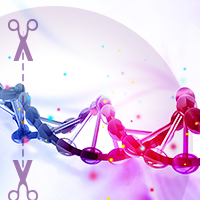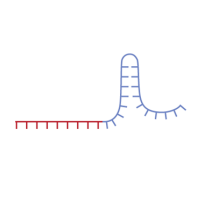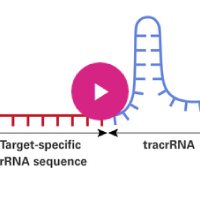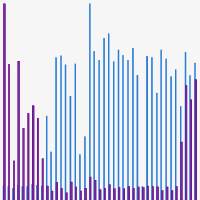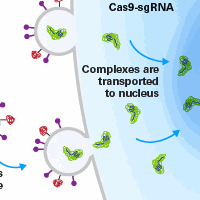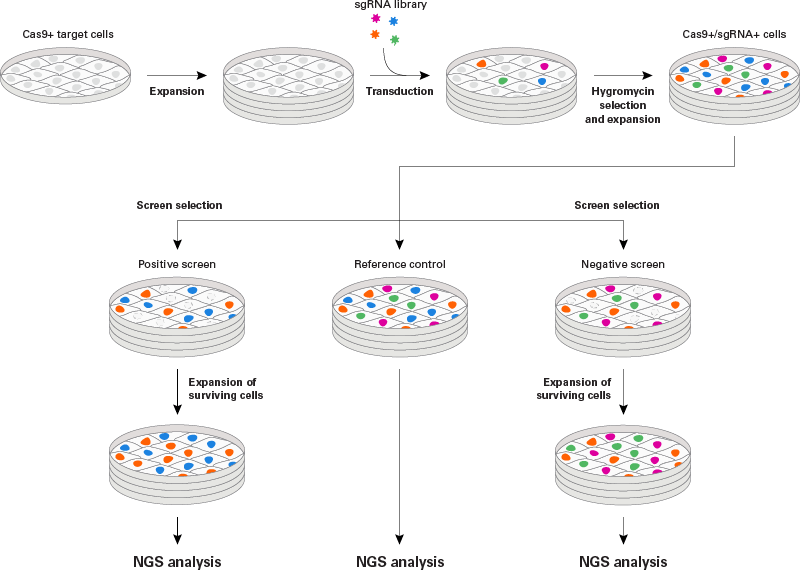Guide-it Genotype Confirmation Kit
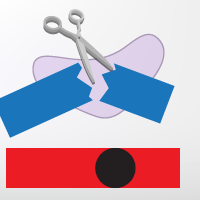
Most mammalian cells carry two copies of most genes. CRISPR/Cas9 gene editing can introduce insertion or deletion mutations (indels) on either one or both copies of a given gene. The Guide-it Genotype Confirmation Kit provides a simple method for determining if a given clone has mutations in one copy (monoallelic), both copies (biallelic), or is unchanged (wild type). The protocol involves amplification of the target site from cells treated with Cas9 and a single guide RNA (sgRNA).
Most mammalian cells carry two copies of most genes. CRISPR/Cas9 gene editing can introduce insertion or deletion mutations (indels) on either one or both copies of a given gene. The Guide-it Genotype Confirmation Kit provides a simple method for determining if a given clone has mutations in one copy (monoallelic), both copies (biallelic), or is unchanged (wild type). The protocol involves amplification of the target site from cells treated with Cas9 and a single guide RNA (sgRNA). The resulting amplicon is used in an in vitro cleavage reaction with recombinant Cas9 and the same sgRNA. The genotype can be determined by resolving the cleavage products on an agarose gel.
Using this kit after gene editing expedites the process of screening a large number of clones for those with the desired genotype. Each kit contains sufficient reagents for 100 extractions, amplifications, and cleavage reactions.
Overview
- In vitro cleavage assay with Cas9 and sgRNA allows for identification of monoallelic and biallelic indels
- Includes highly purified recombinant Cas9 nuclease for in vitro cleavage reactions
- Streamlined protocol that uses direct amplification of target genomic DNA from cells
More Information
Applications
- CRISPR/Cas9 gene editing
- Identification of monoallelic and biallelic mutations after CRISPR/Cas9 gene editing
Additional product information
Please see the product's Certificate of Analysis for information about storage conditions, product components, and technical specifications. Please see the Kit Components List to determine kit components. Certificates of Analysis and Kit Components Lists are located under the Documents tab.
CRISPR/Cas9 information
Choosing sgRNA design tools
Browse a collection of sgRNA design tools for Cas9-based genome editing experiments.
Choosing a target sequence for CRISPR/Cas9 gene editing
Learn how to design sgRNA sequences for successful gene editing.
The CRISPR/Cas9 system for targeted genome editing
Overview of CRISPR/Cas9 system for genome editing.
CRISPR/Cas9 genome editing tools
An overview of tools available for each step in a successful genome editing workflow.
Gene editing technical notes
Delivery of Cas9 and sgRNA to mammalian cells using a variety of innovative tools.
SNP engineering application note
Learn about a simple assay for sensitive detection of single-nucleotide substitutions in bulk-edited or clonal cell populations.
CRISPR/Cas9 gesicles overview
Learn about Guide-it CRISPR/Cas9 Gesicle Production System components and workflow.
CRISPR library screening webinar
Watch this webinar to learn how you can perform genome-wide lentiviral sgRNA screens easily.
Choosing an HDR template format
Watch a webinar on how to choose the right HDR template for knockin experiments.
Guide-it SNP Screening Kit FAQs
Get answers to frequently asked questions and view a video explaining the enzymatic assay.
Takara Bio USA, Inc.
United States/Canada: +1.800.662.2566 • Asia Pacific: +1.650.919.7300 • Europe: +33.(0)1.3904.6880 • Japan: +81.(0)77.565.6999
FOR RESEARCH USE ONLY. NOT FOR USE IN DIAGNOSTIC PROCEDURES. © 2025 Takara Bio Inc. All Rights Reserved. All trademarks are the property of Takara Bio Inc. or its affiliate(s) in the U.S. and/or other countries or their respective owners. Certain trademarks may not be registered in all jurisdictions. Additional product, intellectual property, and restricted use information is available at takarabio.com.



